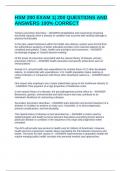Exam (elaborations)
HSM 200 EXAM 1| 200 QUESTIONS AND ANSWERS 100% CORRECT
- Course
- Institution
HSM 200 EXAM 1| 200 QUESTIONS AND ANSWERS 100% CORRECT HSM 200 EXAM 1| 200 QUESTIONS AND ANSWERS 100% CORRECT HSM 200 EXAM 1| 200 QUESTIONS AND ANSWERS 100% CORRECT HSM 200 EXAM 1| 200 QUESTIONS AND ANSWERS 100% CORRECT Tertiary prevention describes: - ANSWER-rehabilitation and maximizi...
[Show more]



